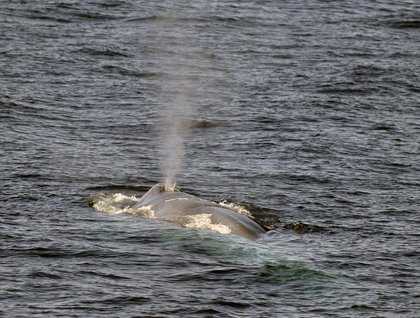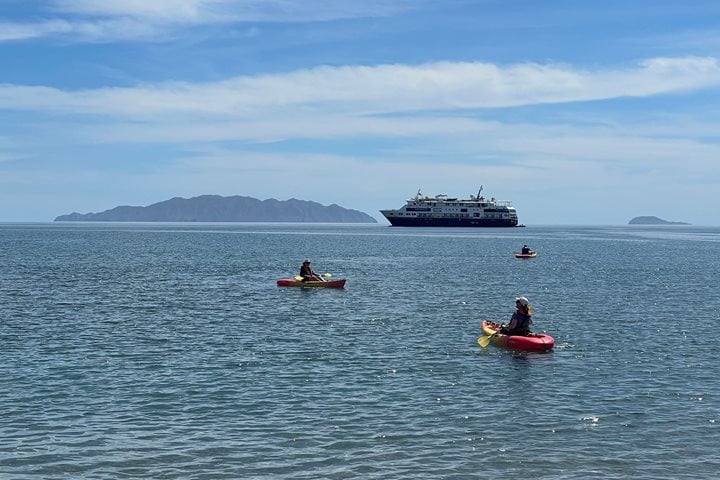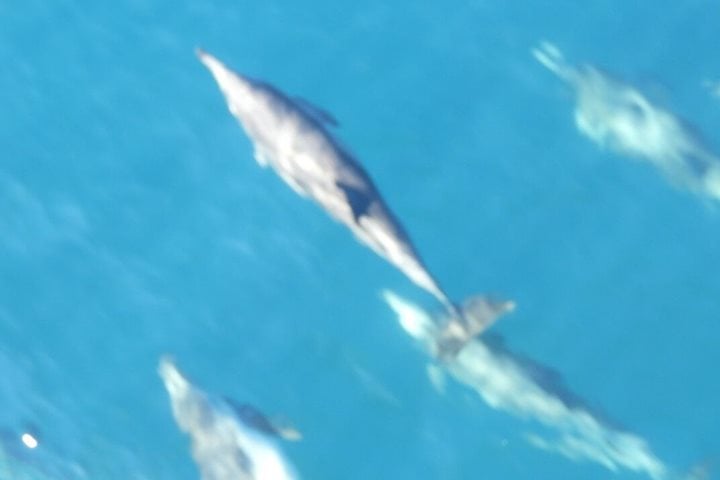The National Geographer Sea Bird continued her journey south throughout the evening, heading towards our next day’s destination of the southern tip of the 1,000 mile long Baja peninsula. About one hour after sunrise our day’s exciting activity began with the sighting of a blue whale. The Captain slowed the National Geographic Sea Bird and the bow was instantly filled with eager viewers watching as the world’s largest animal rose gracefully to the surface, took a long deep breath sending up a 30 foot plume of atomized water into the air! Soon it was discovered that there were two blue whales, one was very relaxed, casually moving in what the natural history staff thought, was a very unusual location for blue whales. They are usually seen quite far north of our present location, slightly north of Gorda Banks, where we were hoping to see marine mammals of a different kind! During the next hour we followed these two animals, watching as one of the blue whales continued to move slowly just under the surface, giving the water a lovely teal color. The whale surfaced, took several breathes and continued its journey plying the food-rich waters of the Gulf of California for its daily meal.
We also adjourned to the dining room for our first meal of the day, followed by a lecture in the forward lounge on marine mammals, given by one of our natural history staff. As Carlos was about midway through his talk an announcement was made...humpback whales, humpback whales...come to the bow! Our entire group made their way to the bow to be greeted by a cow/calf pair of humpbacks. Looking out to sea, a much larger group of animals was spotted and soon the National Geographic Sea Bird was changing her course and heading out to spend some time with quite a large group of competitively active humpback whales. Tail lobbing, head lobbing, flippers splashing, full body throws onto another whale, all of which was happening at a speed of 7 knots. This group of approximately 10 or 12 animals continued to make a zig-zag pattern back and forth in an area called Gorda Banks, well-known for humpback whale activity. For nearly two hours we continued watching this group of humpback whales, as one after another the whales would surface, breath very deeply and then charge out again at each other. The dorsal areas of many of the animals were bloodied and with one closely passing the National Geographic Sea Bird we could see the 15 foot flippers under the water, hear the intense blows and watch as this large group of whales charged past us.
All too soon it was time to continue our journey south towards San Jose del Cabo. Carlos returned to his talk in the lounge and as he was closing his presentation, the staff on the bow lowered the hydrophone and in the distance the song of possibly two humpback whales was picked up and transmitted into the forward lounge of the National Geographic Sea Bird. What a spectacular way to finish a presentation and what a fascinating way to finish our observations of today’s humpback, by being present and listening to a world of communication so different from our own.
Lunch was served while the National Geographic Sea Bird entered the new marina of San Jose del Cabo. The afternoon was spent either birding or exploring this old colonial town established in the early 1700’s. The streets were filled with people getting ready for a very special celebration of St. Joseph’s Day, a commemoration of the establishment of San Jose del Cabo.
Once everyone had returned to the National Geographic Sea Bird in the late afternoon, our ship continued south in the Gulf of California, heading towards Friar’s Rocks or Lands End and the southern tip of the Baja peninsula. Plans were being made for an evening on the bow with cocktails and an evening recap. Suddenly radios started going off all over the ship...from the dining room, to the bow, to the cabins of expedition leader and officers: killer whales had been spotted! All activities for the remainder of the evening were dropped to enjoy this rare sighting. As the sun tipped over the mountains of the Baja peninsula, the last rays of golden light danced off the dorsal fins of a chorus line of Killer whales, adding yet another chapter in our journey so aptly called “among the great whales.”







